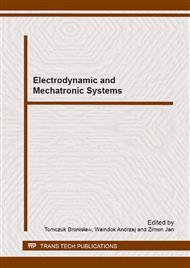[1]
M. Beasley, et al, "Reducing Diesel Emissions Dispersion By Coordinated Combustion Feedback control", SAE Paper 2006-01-0186 (2006)
DOI: 10.4271/2006-01-0186
Google Scholar
[2]
M. Brunt, et al, "The Calculation Of Heat Release Energy From Engine Cylinder Pressure Data", SAE Paper 980152 (1998)
DOI: 10.4271/981052
Google Scholar
[3]
Bieniek A.: Conception of cylinder pressure based diesel injection control system, Journal of KONES, Powertrain and Transport, Vol. 18, No. 3 (2011) 27- 35
Google Scholar
[4]
Bieniek A., Mamala J. Graba M.: Analysis of combustion process at multiphase injection at nonroad diesel engine, Combustion Engines 3/2011(146), PTNSS-2011-SC-190, (2011) 1 – 8
Google Scholar
[5]
W. De Ojeda, A. Karkkainen, "Multicylinder Diesel Engine Design For HCCI Operation", Presentation To The Diesel Engine Emissions Reduction (Deer) Conference (2006)
Google Scholar
[6]
M. Hasegawa, Y. Shimasaki, et al, "Study On Ignition Timing Control For Diesel Engines Using In-Cylinder Pressure Sensor", SAE Paper 2006-01-0180 (2006)
DOI: 10.4271/2006-01-0180
Google Scholar
[7]
J.-A. Kessel, M. Schmidt, R. Isermann, "Modelbasierte Motorsteuerung, Regelung und – Ueberwachung", MTZ Nr 59 (1998) 240-246
DOI: 10.1007/bf03228465
Google Scholar
[8]
M. Kuessel, H. Bellmann, W. Herden, "Brennraum–Drucksensor fuer den Einsatz in Serienmotoren", MTZ Nr 57 (1996) 16-22
Google Scholar
[9]
S. Leonhardt, C. Ludwig, R. Schwarz, "Real-Time Supervision For Diesel Engine Injection", Control Engine Practice, Elsevier Science, Vol. 3, No. 7 (1995) 1003-1010
DOI: 10.1016/0967-0661(95)00084-8
Google Scholar
[10]
S. Leonhardt, R. Isermann, "Echtzeit-Ueberwachung von Diesel-Einspritzanlagen", MTZ Nr 57 (1996) 116-123
Google Scholar
[11]
J. Poleszak, "The Adaptive Control Of The Injection Timing In The Diesel Engine"; Maintaince and Durability, Nr 2 (2003) 52-60
Google Scholar
[12]
M. Sellnau, F. Matekunas, P. Battiston, C. Chang, D. Lancaster, "Cylinder-Pressure-Based Engine Control Using Pressure-Ratio-Management and Low-Cost Non-Intrusive Cylinder Pressure Sensors", SAE Paper No 2000-01-0932, SAE World Congress (2000) 1-20
DOI: 10.4271/2000-01-0932
Google Scholar
[13]
Y. Shiao, J. Moskwa, "Cylinder Pressure and Combustion Heat Release Estimation for SI Engine Diagnostics Using Nonlinear Sliding Observers", IEEE Transactions On Control Systems Technology Vol. 3 No 1 (1995) 1-14
DOI: 10.1109/87.370712
Google Scholar
[14]
M. Wlodarczyk, "High Accurancy Glow Plug-Inegrated Pressure Sensor For Closed Loop Engine Control", MTZ. Worldwide 11 Volume 60 (2004)
Google Scholar
[15]
S. Drakunov, G. Rizzoni, Estimation of Engine Torque Using Nonlinear Observers in the Crank Angle Domain, Proc 5th ASME Symposium of AdvancedAutomotive Technologies ASME, IMECE, US (1995)
Google Scholar
[16]
S. Schagerberg, T. McKelvey: "Instantaneous Crankschaft Torque Measurmennts –Modelling and Validation", SAE Tachnical Paper 2003-01—0713 (2003)
DOI: 10.4271/2003-01-0713
Google Scholar
[17]
S. Larsson, S. Schagerberg: "SI-Engine Cylinder Pressure Estimation using Torque Sensors", SAE Technical Paper 2004-01-1369 (2003)
DOI: 10.4271/2004-01-1369
Google Scholar
[18]
Y.Shimasaki, M. Kobayashi, H. Sakamoto, M. Ueno, et al.: "Study on Engine Managemaent System Using In-cylinder Pressure Sensor Integrated with Spark Plug" SAE Technical Paper 2004-01-0519 (2004)
DOI: 10.4271/2004-01-0519
Google Scholar
[19]
D. Taraza: "Quantifying Relationship Between the Crankshaft's Speed Variation and the Gas Pressure Torque" SAE Technical Paper 2001-01-1007 (2001)
DOI: 10.4271/2001-01-1007
Google Scholar
[20]
G. Rizzoni, F. Connolly F.: "Estimate of IC Engine Torque from Measurment of Crankshaft Angular Position", SAE Technical Paper 932410 (1993)
DOI: 10.4271/932410
Google Scholar


